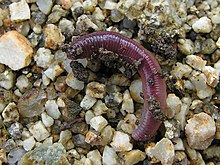Clitellata
| Clitellata Temporal range: Triassic–Recent |
|
|---|---|
 |
|
| Earthworm | |
| Scientific classification | |
| Kingdom: | Animalia |
| Phylum: | Annelida |
| Class: | Clitellata |
| Subclasses | |
|
Branchiobdellae |
|
Branchiobdellae
Hirudinea
"Oligochaeta" (paraphyletic)
and see text
The Clitellata are a class of annelid worms, characterized by having a clitellum - the 'collar' that forms a reproductive cocoon during part of their life cycles. The clitellates comprise around 8,000 species. Unlike the class of Polychaeta, they do not have parapodia and their heads are less developed.
Most clitellates live on land, in freshwater or in the ocean.
All clitellata are hermaphrodites. During reproduction, the clitellum secretes a coat which hardens. The worm then creeps out backward from the coat and deposits either fertilized zygotes or both ovae and sperm into the coat, which is then packed into a cocoon. The zygotes then develop directly in the cocoon without passing through a larval stage (as opposed to other annelids, e.g. Polychaeta.) This mechanism is considered to be apomorphic (a newly derived characteristic rather than an evolutionarily ancestral one).
According to modern phylogenetic analyses, the Clitellata are considered to be a monophyletic subclade of the polychaetes.
Historically, the group was classified into the subclasses Oligochaeta and the Hirudinea. The oligochaetes contained the tubificids (Naididae, Lumbricidae, and Lumbriculidae - commonly the tube worms and the earthworms. The Hirudinea contained the leeches and the branchiobdellids. Modern analysis has revealed Branchiobdella and Hirudinea are two sister groups to the lumbriculids and they are daughter groups to the tree of oligochaetes. Hence, the terms Oligochaeta and Clitellata are considered synonymous.
...
Wikipedia
